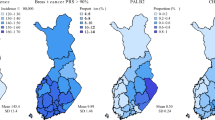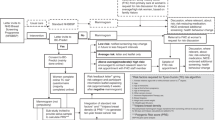Abstract
Identifying a strategy that would optimize both the communication and understanding of the individual breast cancer risk remains a considerable challenge. This study explored the preferences of women with a family history of breast cancer about six presentation formats of individual breast cancer risk, as calculated from a risk prediction model. Thirty-four unaffected women attending genetic counseling because of a family history of breast cancer participated in six focus groups conducted in Québec City (2), Montréal (2) and Toronto (2), Canada. Six risk formats were presented for a fictitious case involving a 35-year-old woman (1—numerical: cumulative risk probabilities by age until 80 years; 2—risk curves: probabilities expressed in a risk curve that also provided a risk curve for a woman with no family history in first-degree relatives; 3—relative risk of breast cancer by age 80 years; 4 and 5—absolute risk of breast cancer and absolute chance of not developing breast cancer in the next 20 years; 6—qualitative: color-coded figure). Participants were asked to indicate their appreciation of each format. A group discussion followed during which participants commented on each format. The most and least appreciated formats were risk curves and relative risk, respectively. Overall, participants advocated the use of formats that combine quantitative, qualitative and visual features. Using a combination of approaches to communicate individual breast cancer risks could be associated with higher satisfaction of counselees. Given the increasing use of risk prediction models, it may be relevant to consider the preferences of both the counselee and the professional.
Similar content being viewed by others
Log in or create a free account to read this content
Gain free access to this article, as well as selected content from this journal and more on nature.com
or
References
Weitzel JN, Blazer KR, Macdonald DJ, Culver JO, Offit K : Genetics, genomics, and cancer risk assessment: state of the art and future directions in the era of personalized medicine. CA Cancer J Clin 2011; 61: 327–359.
Anothaisintawee T, Teerawattananon Y, Wiratkapun C, Kasamesup V, Thakkinstian A : Risk prediction models of breast cancer: a systematic review of model performances. Breast Cancer Res Treat 2011; 133: 1–10.
Meads C, Ahmed I, Riley RD : A systematic review of breast cancer incidence risk prediction models with meta-analysis of their performance. Breast Cancer Res Treat 2012; 132: 365–377.
Amir E, Freedman OC, Seruga B, Evans DG : Assessing women at high risk of breast cancer: a review of risk assessment models. J Natl Cancer Inst 2010; 102: 680–691.
Smith RA, Cokkinides V, Brooks D, Saslow D, Shah M, Brawley OW : Cancer screening in the United States, 2011: a review of current American Cancer Society Guidelines and Issues in Cancer Screening. CA Cancer J Clin 2011; 61: 8–30.
Sivell S, Elwyn G, Gaff C et al: How risk is perceived, constructed and interpreted by clients in clinical genetics, and the effects on decision making: Systematic Review. J Genet Couns 2008; 17: 30–63.
Davison C, Smith GD, Frankel S : Lay epidemiology and the prevention paradox: the implications of coronary candidacy for health education. Sociol Health Ill 1991; 13: 1–19.
Antoniou AC, Cunningham AP, Peto J et al: The BOADICEA model of genetic susceptibility to breast and ovarian cancers: updates and extensions. Br J Cancer 2008; 98: 1457–1466.
Antoniou AC, Pharoah PPD, Smith P, Easton DF : The BOADICEA model of genetic susceptibility to breast and ovarian cancer. Br J Cancer 2004; 91: 1580–1590.
Wacholder S, Hartge P, Prentice R et al: Performance of common genetic variants in breast-cancer risk models. N Engl J Med 2010; 362: 986–993.
Julian-Reynier C, Welkenhuysen M, Hagoel L, Decruyenaere M, Hopwood P : Risk communication strategies: state of the art and effectiveness in the context of cancer genetic services. Eur J Hum Genet 2003; 11: 725–736.
Edwards A, Gray J, Clarke A et al: Interventions to improve risk communication in clinical genetics: systematic review. Patient Educ Couns 2008; 71: 4–25.
Krueger R, Casey MA : Focus Groups, a Pratical Guide for Applied Research 4th edn, Thousand Oaks, CA: Sage Publications, 2009.
Cull A, Anderson EDC, Campbell S, Mackay J, Smyth E, Steel M : The impact of genetic counselling about breast cancer risk on women's risk perceptions and levels of distress. Br J Cancer 1999; 79: 501–508.
Goodyear-Smith F, Arroll B, Chan L, Jackson R, Wells S, Kenealy T : Patients prefer pictures to numbers to express cardiovascular benefit from treatment. Ann Fam Med 2008; 6: 213–217.
Vahabi M : The impact of health communication on health-related decision making A review of evidence. Health Educ 2007; 107: 27–41.
Edwards A, Elwyn G, Covey J, Matthews E, Pill R : Presenting risk information: a review of the effects of framing and other manipulations on patient outcomes. J Health Commun 2001; 6: 61–82.
Schwartz LM, Woloshin S, Black WC, Welch HG : The role of numeracy in understanding the benefit of screening mammography. Ann Intern Med 1997; 127: 966–972.
Hutson SP : Attitudes and psychological impact of genetic testing, genetic counseling, and breast cancer risk assessment among women at increased risk. Oncol Nurs Forum 2003; 30: 241–246.
Austin J : Re-conceptualizing risk in genetic counseling: implications for clinical practice. J Genet Couns 2010; 19: 228–234.
Safeer RS, Keenan J : Health literacy: the gap between physicians and patients. Am Fam Physician 2005; 72: 463–468.
Wright AJ, Whitwell SC, Takeichi C, Hankins M, Marteau TM : The impact of numeracy on reactions to different graphic risk presentation formats: an experimental analogue study. Br J Health Psychol 2009; 14: 107–125.
Reyna VF, Nelson WL, Han PK, Dieckmann NF : How numeracy influences risk comprehension and medical decision making. Psychol Bull 2009; 135: 943–973.
Statistics Canada: Building on our Competencies: Canadian Results of the International Adult Literacy and Skills Survey [Catalogue no. 89-617-XIE] 2003.
Galesic M, Garcia-Retamero R : Statistical numeracy for health: a cross-cultural comparison with probabilistic national samples. Arch Intern Med 2010; 170: 462–468.
Lipkus IM, Samsa G, Rimer BK : General performance on a numeracy scale among highly educated samples. Med Decis Making 2001; 21: 37–44.
Davids SL, Schapira MM, McAuliffe TL, Nattinger AB : Predictors of pessimistic breast cancer risk perceptions in a primary care population. J Gen Intern Med 2004; 19: 310–315.
Lobb EA, Butow PN, Meiser B et al: Women's preferences and consultants' communication of risk in consultations about familial breast cancer: impact on patient outcomes. J Med Genet 2003; 40: e56.
Pieterse AH, van Dulmen S, van Dijk S, Bensing JM, Ausems MG : Risk communication in completed series of breast cancer genetic counseling visits. Genet Med 2006; 8: 688–696.
Welkenhuysen M, Evers-Kiebooms G, d’Ydewalle G : The language of uncertainty in genetic risk communication: framing and verbal versus numerical information. Patient Educ Couns 2001; 43: 179–187.
Ancker JS, Senathirajah Y, Kukafka R, Starren JB : Design features of graphs in health risk communication: a systematic review. J Am Med Inform Assoc 2006; 13: 608–618.
Dolan J : The importance of form, content, and context in the design and effectiveness of risk communication methods. Cancer Prev Res 2010; 3: Abstract # CN15-03; doi:10.1158/1940-6207-10-CN15-03.
Garcia-Retamero R, Galesic M : How to reduce the effect of framing on messages about health. J Gen Intern Med 2010; 25: 1323–1329.
Schapira MM, Nattinger AB, McAuliffe TL : The influence of graphic format on breast cancer risk communication. J Health Commun 2006; 11: 569–582.
Hawley ST, Zikmund-Fisher B, Ubel P, Jancovic A, Lucas T, Fagerlin A : The impact of the format of graphical presentation on health-related knowledge and treatment choices. Patient Educ Couns 2008; 73: 448–455.
Lipkus IM, Hollands JG : The Visual Communication of Risk. J Natl Cancer Inst Monogr 1999; 25: 149–163.
Han PKJ, Klein WMP, Lehman T, Killam B, Massett H, Freedman AN : Communication of uncertainty regarding individualized cancer risk estimates: effects and influential factors. Med Decis Making 2011; 31: 354–366.
Noar SM, Mehrotra P : Toward a new methodological paradigm for testing theories of health behavior and health behavior change. Patient Educ Couns 2010; 82: 468–474.
Phipps S, Zinn AB, Opitz JM, Reynolds JF : Psychological response to amniocentesis: II. Effects of coping style. Am J Med Genet 1986; 25: 143–148.
Bottorff JL, Ratner PA, Johnson JL, Lovato CY, Joab SA : Communicating cancer risk information: the challenges of uncertainty. Patient Educ Couns 1998; 33: 67–81.
Vernon SW : Risk perception and risk communication for cancer screening behaviors: a review. J Natl Cancer Inst 1999; 91: 101.
Miller SM : Monitoring versus blunting styles of coping with cancer influence the information patients want and need about their disease. Implications for cancer screening and management. Cancer 1995; 76: 167–177.
Tong A, Sainsbury P, Craig J : Consolidated criteria for reporting qualitative research (COREQ): a 32-item checklist for interviews and focus groups. Int J Qual Health Care 2007; 19: 349–357.
Ortendahl M, Fries JF : Framing health messages based on anomalies in time preference. Med Sci Monit 2005; 11: RA253–RA256.
Brown SM, Culver JO, Osann KE et al: Health literacy, numeracy, and interpretation of graphical breast cancer risk estimates. Patient Educ Couns 2011; 83: 92–98.
Walter FM, Emery J, Braithwaite D, Marteau TM : Lay understanding of familial risk of common chronic diseases: a systematic review and synthesis of qualitative research. Ann Fam Med 2004; 2: 583–594.
Ellington L, Kelly KM, Reblin M, Latimer S, Roter D : Communication in genetic counseling: cognitive and emotional processing. Health Commun 2011; 26: 667–675.
Gail MH, Brinton LA, Byar DP et al: Projecting individualized probabilities of developing breast cancer for White females who are being examined annually. J Natl Cancer Inst 1989; 81: 1879–1886.
Rockhill B, Spiegelman D, Byrne C, Hunter DJ, Colditz GA : Validation of the Gail et al. model of breast cancer risk prediction and implications for chemoprevention. J Natl Cancer Inst 2001; 93: 358–366.
Gail MH, Mai PL : Comparing breast cancer risk assessment models. J Natl Cancer Inst 2010; 102: 665–668.
Acknowledgements
We thank all study participants for the invaluable contribution of their time and effort. We also wish to thank the following people for their ongoing support of this research project: Stéphanie Côté (recruitment), Josée Rhéaume (recruitment), Claudia Côté (data and quality management), Ursula Donovan (linguistic revision), Christine Melançon (moderator) and Tom Rygby (report and analyses) from Ipsos Descarie.
Research support: The research program is supported by the Canadian Institutes of Health Research for the “CIHR Team in Familial Risks of Breast Cancer” program (CIHR; CRN-87521) and the Ministry of Economic Development, Innovation and Export Trade of Quebec (PSR-SIIRI-701); MD held a Fonds de la Recherche en Santé du Québec research Fellowship when this work was done; JS is Chair holder of the Canada Research Chair in Oncogenetics.
Author information
Authors and Affiliations
Corresponding author
Ethics declarations
Competing interests
The authors declare no conflict of interest.
Additional information
Supplementary Information accompanies the paper on European Journal of Human Genetics website
Supplementary information
Rights and permissions
About this article
Cite this article
Dorval, M., Bouchard, K., Chiquette, J. et al. A focus group study on breast cancer risk presentation: one format does not fit all. Eur J Hum Genet 21, 719–724 (2013). https://doi.org/10.1038/ejhg.2012.248
Received:
Revised:
Accepted:
Published:
Issue date:
DOI: https://doi.org/10.1038/ejhg.2012.248
Keywords
This article is cited by
-
Whether, when, how, and how much? General public’s and cancer patients’ views about the disclosure of genomic secondary findings
BMC Medical Genomics (2021)
-
A randomised controlled trial of the effect of providing online risk information and lifestyle advice for the most common preventable cancers: study protocol
BMC Public Health (2018)
-
Responses to provision of personalised cancer risk information: a qualitative interview study with members of the public
BMC Public Health (2017)
-
Experience of Norwegian Female BRCA1 and BRCA2 Mutation‐Carrying Participants in Educational Support Groups: a Qualitative Study
Journal of Genetic Counseling (2016)
-
iPrevent®: a tailored, web-based, decision support tool for breast cancer risk assessment and management
Breast Cancer Research and Treatment (2016)



